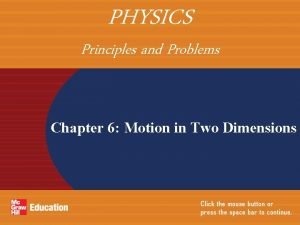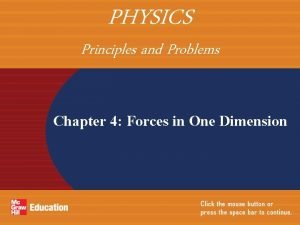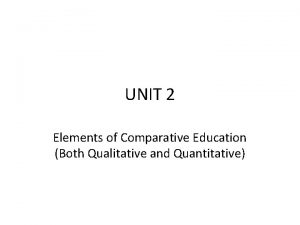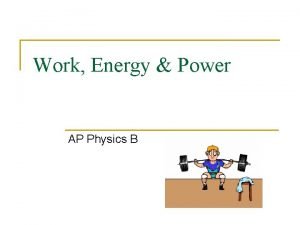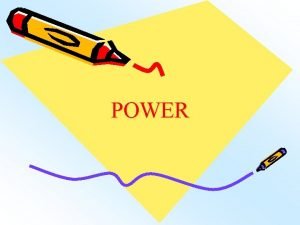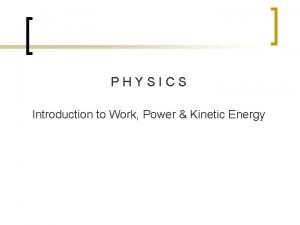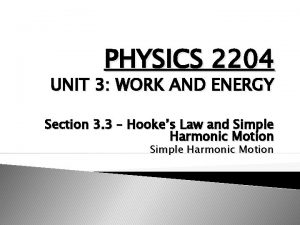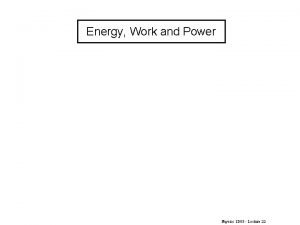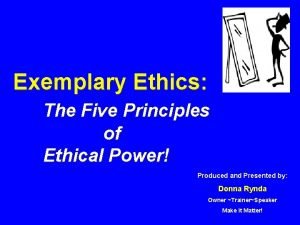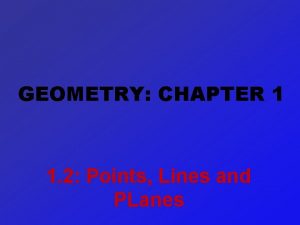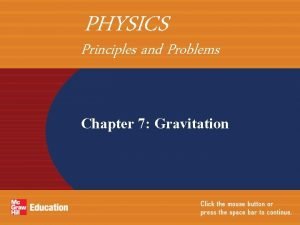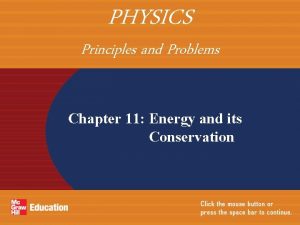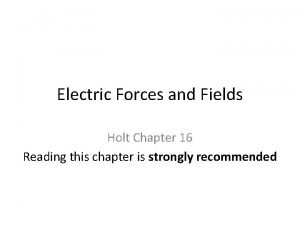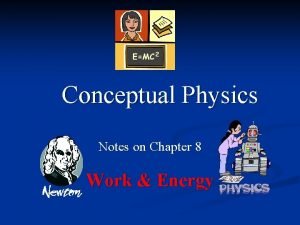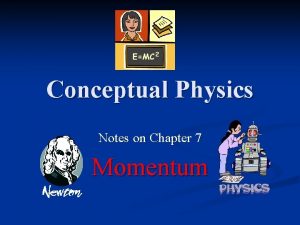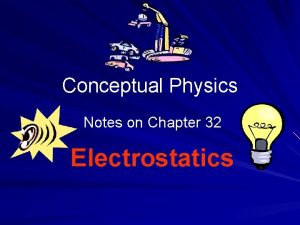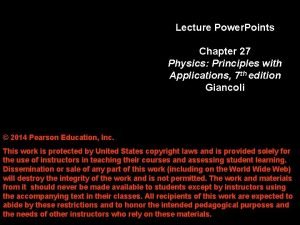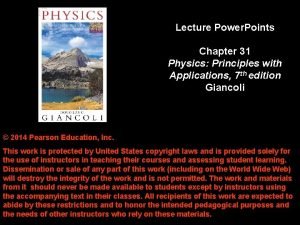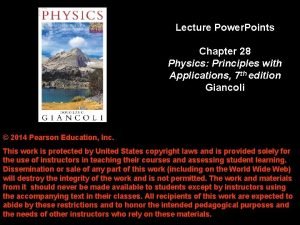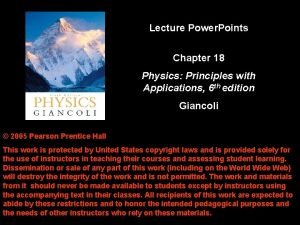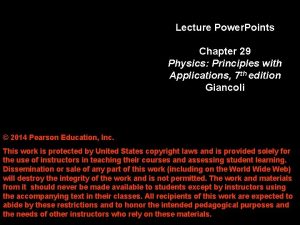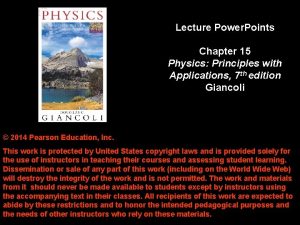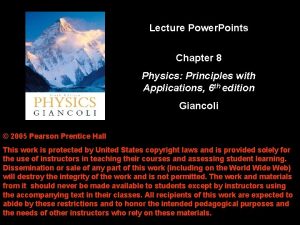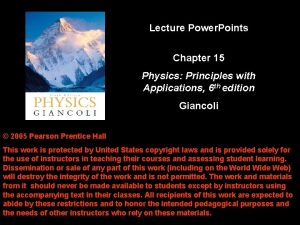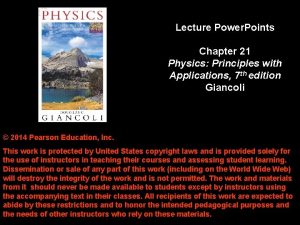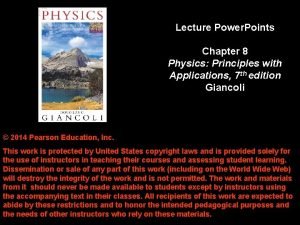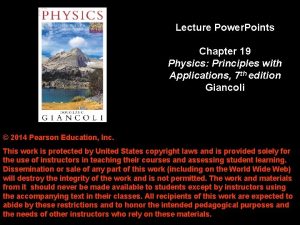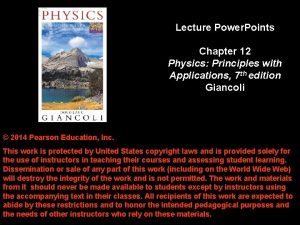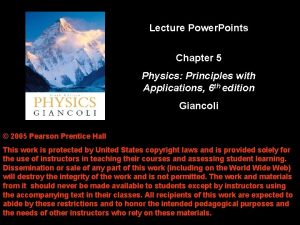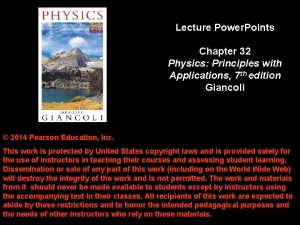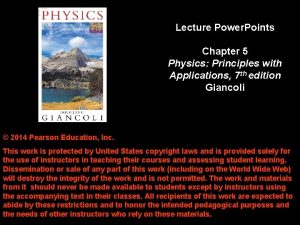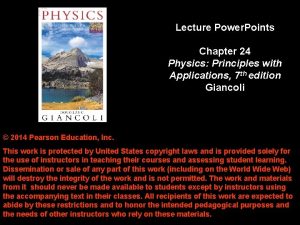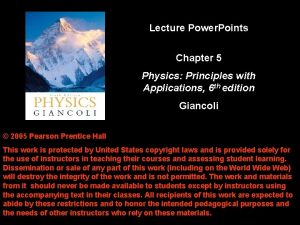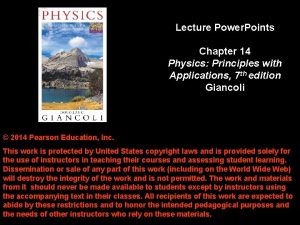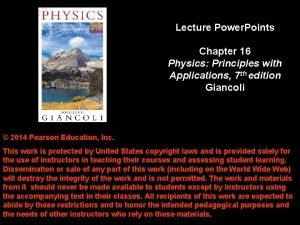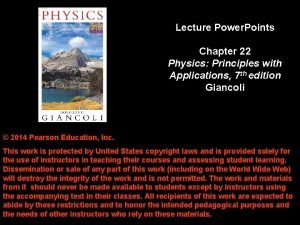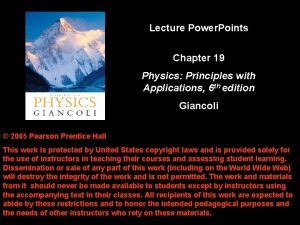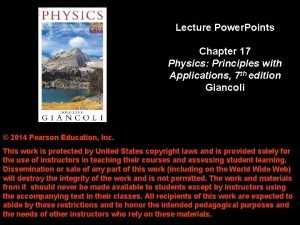Lecture Power Points Chapter 11 Physics Principles with
























































- Slides: 56

Lecture Power. Points Chapter 11 Physics: Principles with Applications, 7 th edition Giancoli © 2014 Pearson Education, Inc. This work is protected by United States copyright laws and is provided solely for the use of instructors in teaching their courses and assessing student learning. Dissemination or sale of any part of this work (including on the World Wide Web) will destroy the integrity of the work and is not permitted. The work and materials from it should never be made available to students except by instructors using the accompanying text in their classes. All recipients of this work are expected to abide by these restrictions and to honor the intended pedagogical purposes and the needs of other instructors who rely on these materials.

Chapter 11 Oscillations and Waves © 2014 Pearson Education, Inc.

Contents of Chapter 11 • Simple Harmonic Motion—Spring Oscillations • Energy in Simple Harmonic Motion • The Period and Sinusoidal Nature of SHM • The Simple Pendulum • Damped Harmonic Motion • Forced Oscillations; Resonance • Wave Motion • Types of Waves and Their Speeds: Transverse and Longitudinal © 2014 Pearson Education, Inc.

Contents of Chapter 11 • Energy Transported by Waves • Reflection and Transmission of Waves • Interference; Principle of Superposition • Standing Waves; Resonance • Refraction • Diffraction • Mathematical Representation of a Traveling Wave © 2014 Pearson Education, Inc.

11 -1 Simple Harmonic Motion—Spring Oscillations If an object vibrates or oscillates back and forth over the same path, each cycle taking the same amount of time, the motion is called periodic. The mass and spring system is a useful model for a periodic system. © 2014 Pearson Education, Inc.

11 -1 Simple Harmonic Motion—Spring Oscillations We assume that the surface is frictionless. There is a point where the spring is neither stretched nor compressed; this is the equilibrium position. We measure displacement from that point (x = 0 on the previous figure). The force exerted by the spring depends on the displacement: (11 -1) © 2014 Pearson Education, Inc.

11 -1 Simple Harmonic Motion—Spring Oscillations • The minus sign on the force indicates that it is a restoring force—it is directed to restore the mass to its equilibrium position. • k is the spring constant • The force is not constant, so the acceleration is not constant either © 2014 Pearson Education, Inc.

11 -1 Simple Harmonic Motion—Spring Oscillations • Displacement is measured from the equilibrium point • Amplitude is the maximum displacement • A cycle is a full to-and-fro motion; this figure shows half a cycle • Period is the time required to complete one cycle • Frequency is the number of cycles completed per second © 2014 Pearson Education, Inc.

11 -1 Simple Harmonic Motion—Spring Oscillations If the spring is hung vertically, the only change is in the equilibrium position, which is at the point where the spring force equals the gravitational force. © 2014 Pearson Education, Inc.

11 -1 Simple Harmonic Motion—Spring Oscillations Any vibrating system where the restoring force is proportional to the negative of the displacement is in simple harmonic motion (SHM), and is often called a simple harmonic oscillator. © 2014 Pearson Education, Inc.

11 -2 Energy in Simple Harmonic Motion We already know that the potential energy of a spring is given by: PE = ½ kx 2 The total mechanical energy is then: (11 -3) The total mechanical energy will be conserved, as we are assuming the system is frictionless. © 2014 Pearson Education, Inc.

11 -2 Energy in Simple Harmonic Motion If the mass is at the limits of its motion, the energy is all potential. If the mass is at the equilibrium point, the energy is all kinetic. We know what the potential energy is at the turning points: (11 -4 a) © 2014 Pearson Education, Inc.

11 -2 Energy in Simple Harmonic Motion The total energy is, therefore ½ k. A 2 And we can write: (11 -4 c) This can be solved for the velocity as a function of position: (11 -5 b) where © 2014 Pearson Education, Inc. (11 -5 a)

11 -3 The Period and Sinusoidal Nature of SHM If we look at the projection onto the x axis of an object moving in a circle of radius A at a constant speed vmax, we find that the x component of its velocity varies as: (11 -5 b) This is identical to SHM. © 2014 Pearson Education, Inc.

11 -3 The Period and Sinusoidal Nature of SHM Therefore, we can use the period and frequency of a particle moving in a circle to find the period and frequency: (11 -6 a) (11 -6 b) © 2014 Pearson Education, Inc.

11 -3 The Period and Sinusoidal Nature of SHM We can similarly find the position as a function of time: (11 -8 a) (11 -8 b) (11 -8 c) © 2014 Pearson Education, Inc.

11 -3 The Period and Sinusoidal Nature of SHM The top curve is a graph of the previous equation. The bottom curve is the same, but shifted ¼ period so that it is a sine function rather than a cosine. © 2014 Pearson Education, Inc.

11 -3 The Period and Sinusoidal Nature of SHM The velocity and acceleration can be calculated as functions of time; the results are below, and are plotted at left. (11 -9) (11 -10) © 2014 Pearson Education, Inc.

11 -4 The Simple Pendulum A simple pendulum consists of a mass at the end of a lightweight cord. We assume that the cord does not stretch, and that its mass is negligible. © 2014 Pearson Education, Inc.

11 -4 The Simple Pendulum In order to be in SHM, the restoring force must be proportional to the negative of the displacement. Here we have F = ‑mg sin θ which is proportional to sin θ and not to θ itself. However, if the angle is small, sin θ ≈ θ. © 2014 Pearson Education, Inc.

11 -4 The Simple Pendulum Therefore, for small angles, the force is approximately proportional to the angular displacement. The period and frequency are: (11 -11 a) (11 -11 b) © 2014 Pearson Education, Inc.

11 -4 The Simple Pendulum So, as long as the cord can be considered massless and the amplitude is small, the period does not depend on the mass. © 2014 Pearson Education, Inc.

11 -5 Damped Harmonic Motion Damped harmonic motion is harmonic motion with a frictional or drag force. If the damping is small, we can treat it as an “envelope” that modifies the undamped oscillation. © 2014 Pearson Education, Inc.

11 -5 Damped Harmonic Motion However, if the damping is large, it no longer resembles SHM at all. A: underdamping: there a few small oscillations before the oscillator comes to rest. B: critical damping: this is the fastest way to get to equilibrium. C: overdamping: the system is slowed so much that it takes a long time to get to equilibrium. © 2014 Pearson Education, Inc.

11 -5 Damped Harmonic Motion There are systems where damping is unwanted, such as clocks and watches. Then there are systems in which it is wanted, and often needs to be as close to critical damping as possible, such as automobile shock absorbers and earthquake protection for buildings. © 2014 Pearson Education, Inc.

11 -6 Forced Oscillations; Resonance Forced vibrations occur when there is a periodic driving force. This force may or may not have the same period as the natural frequency of the system. If the frequency is the same as the natural frequency, the amplitude becomes quite large. This is called resonance. © 2014 Pearson Education, Inc.

11 -6 Forced Oscillations; Resonance The sharpness of the resonant peak depends on the damping. If the damping is small (A), it can be quite sharp; if the damping is larger (B), it is less sharp. Like damping, resonance can be wanted or unwanted. Musical instruments and TV/radio receivers depend on it. © 2014 Pearson Education, Inc.

11 -7 Wave Motion A wave travels along its medium, but the individual particles just move up and down. © 2014 Pearson Education, Inc.

11 -7 Wave Motion All types of traveling waves transport energy. Study of a single wave pulse shows that it is begun with a vibration and transmitted through internal forces in the medium. Continuous waves start with vibrations too. If the vibration is SHM, then the wave will be sinusoidal. © 2014 Pearson Education, Inc.

11 -7 Wave Motion Wave characteristics: • Amplitude, A • Wavelength, λ • Frequency f and period T • Wave velocity © 2014 Pearson Education, Inc. (11 -12)

11 -8 Types of Waves and Their Speeds: Transverse and Longitudinal The motion of particles in a wave can either be perpendicular to the wave direction (transverse) or parallel to it (longitudinal). © 2014 Pearson Education, Inc.

11 -8 Types of Waves and Their Speeds: Transverse and Longitudinal Sound waves are longitudinal waves: © 2014 Pearson Education, Inc.

11 -8 Types of Waves and Their Speeds : Transverse and Longitudinal Earthquakes produce both longitudinal and transverse waves. Both types can travel through solid material, but only longitudinal waves can propagate through a fluid—in the transverse direction, a fluid has no restoring force. Surface waves are waves that travel along the boundary between two media. © 2014 Pearson Education, Inc.

11 -9 Energy Transported by Waves Just as with the oscillation that starts it, the energy transported by a wave is proportional to the square of the amplitude. Definition of intensity: The intensity is also proportional to the square of the amplitude: (11 -15) © 2014 Pearson Education, Inc.

11 -9 Energy Transported by Waves If a wave is able to spread out three-dimensionally from its source, and the medium is uniform, the wave is spherical. the Just from geometrical considerations, as long as power output is constant, we see: (11 -16 b) © 2014 Pearson Education, Inc.

11 -9 Energy Transported by Waves By looking at the energy of a particle of matter in the medium of the wave, we find: (11 -17 a) Then, assuming the entire medium has the same density, we find: (11 -18) Therefore, the intensity is proportional to the square of the frequency and to the square of the amplitude. © 2014 Pearson Education, Inc.

11 -10 Reflection and Transmission of Waves A wave reaching the end of its medium, but where the medium is still free to move, will be reflected (b), and its reflection will be upright. A wave hitting an obstacle will be reflected (a), and its reflection will be inverted. © 2014 Pearson Education, Inc.

11 -10 Reflection and Transmission of Waves A wave encountering a denser medium will be partly reflected and partly transmitted; if the wave speed is less in the denser medium, the wavelength will be shorter. © 2014 Pearson Education, Inc.

11 -10 Reflection and Transmission of Waves Two- or three-dimensional waves can be represented by wave fronts, which are curves of surfaces where all the waves have the same phase. Lines perpendicular to the wave fronts are called rays; they point in the direction of propagation of the wave. © 2014 Pearson Education, Inc.

11 -10 Reflection and Transmission of Waves The law of reflection: the angle of incidence equals the angle of reflection. © 2014 Pearson Education, Inc.

11 -11 Interference; Principle of Superposition The superposition principle says that when two waves pass through the same point, the displacement is the arithmetic sum of the individual displacements. In the figure below, (a) exhibits destructive interference and (b) exhibits constructive interference. © 2014 Pearson Education, Inc.

11 -11 Interference; Principle of Superposition These figures show the sum of two waves. In (a) they add constructively; in (b) they add destructively; and in (c) they add partially destructively. © 2014 Pearson Education, Inc.

11 -12 Standing Waves; Resonance Standing waves occur when both ends of a string are fixed. In that case, only waves which are motionless at the ends of the string can persist. There are nodes, where the amplitude is always zero, and antinodes, where the amplitude varies from zero to the maximum value. © 2014 Pearson Education, Inc.

11 -12 Standing Waves; Resonance The frequencies of the standing waves on a particular string are called resonant frequencies. They are also referred to as the fundamental and harmonics. © 2014 Pearson Education, Inc.

11 -12 Standing Waves; Resonance The wavelengths and frequencies of standing waves are: (11 -19 a) (11 -19 b) © 2014 Pearson Education, Inc.

11 -13 Refraction If the wave enters a medium where the wave speed is different, it will be refracted—its wave fronts and rays will change direction. We can calculate the angle of refraction, which depends on both wave speeds: (11 -20) © 2014 Pearson Education, Inc.

11 -13 Refraction The law of refraction works both ways—a wave going from a slower medium to a faster one would follow the red line in the other direction. © 2014 Pearson Education, Inc.

11 -14 Diffraction When waves encounter an obstacle, they bend around it, leaving a “shadow region. ” This is called diffraction. © 2014 Pearson Education, Inc.

11 -14 Diffraction The amount of diffraction depends on the size of the obstacle compared to the wavelength. If the obstacle is much smaller than the wavelength, the wave is barely affected (a). If the object is comparable to, or larger than, the wavelength, diffraction is much more significant (b, c, d). © 2014 Pearson Education, Inc.

11 -15 Mathematical Representation of a Traveling Wave To the left, we have a snapshot of a traveling wave at a single point in time. Below left, the same wave is shown traveling. © 2014 Pearson Education, Inc.

11 -15 Mathematical Representation of a Traveling Wave A full mathematical description of the wave describes the displacement of any point as a function of both distance and time: (11 -22) © 2014 Pearson Education, Inc.

Summary of Chapter 11 • For SHM, the restoring force is proportional to the displacement. • The period is the time required for one cycle, and the frequency is the number of cycles per second. • Period for a mass on a spring: (11 -6 a) • SHM is sinusoidal. • During SHM, the total energy is continually changing from kinetic to potential and back. © 2014 Pearson Education, Inc.

Summary of Chapter 11 • A simple pendulum approximates SHM if its amplitude is not large. Its period in that case is: (11 -11 a) • When friction is present, the motion is damped. • If an oscillating force is applied to a SHO, its amplitude depends on how close to the natural frequency the driving frequency is. If it is close, the amplitude becomes quite large. This is called resonance. © 2014 Pearson Education, Inc.

Summary of Chapter 11 • Vibrating objects are sources of waves, which may be either a pulse or continuous. • Wavelength: distance between successive crests. • Frequency: number of crests that pass a given point per unit time. • Amplitude: maximum height of crest. • Wave velocity: v = λf © 2014 Pearson Education, Inc.

Summary of Chapter 11 • Transverse wave: oscillations perpendicular to direction of wave motion. • Longitudinal wave: oscillations parallel to direction of wave motion. • Intensity: energy per unit time crossing unit area (W/m 2): (11 -16 b) • Angle of reflection is equal to angle of incidence. © 2014 Pearson Education, Inc.

Summary of Chapter 11 • When two waves pass through the same region of space, they interfere. Interference may be either constructive or destructive. • Standing waves can be produced on a string with both ends fixed. The waves that persist are at the resonant frequencies. • Nodes occur where there is no motion; antinodes where the amplitude is maximum. • Waves refract when entering a medium of different wave speed, and diffract around obstacles. © 2014 Pearson Education, Inc.
 01:640:244 lecture notes - lecture 15: plat, idah, farad
01:640:244 lecture notes - lecture 15: plat, idah, farad Real power and reactive power
Real power and reactive power Correlational points of parity examples
Correlational points of parity examples Points of parity and points of difference
Points of parity and points of difference Physics 111 lecture notes
Physics 111 lecture notes Physics 101 lecture notes pdf
Physics 101 lecture notes pdf Physics 101 lecture 1
Physics 101 lecture 1 Physics 101 lecture notes pdf
Physics 101 lecture notes pdf Physics waves notes pdf
Physics waves notes pdf Atmospheric physics lecture notes
Atmospheric physics lecture notes Physics principles and problems chapter 6 answers
Physics principles and problems chapter 6 answers Chapter 4 assessment physics
Chapter 4 assessment physics Chapter 2 assessment physics answers
Chapter 2 assessment physics answers Principles of economics powerpoint lecture slides
Principles of economics powerpoint lecture slides Objectives of comparative education
Objectives of comparative education Power system dynamics and stability lecture notes
Power system dynamics and stability lecture notes Zline 667-36
Zline 667-36 Power semiconductor devices lecture notes
Power semiconductor devices lecture notes Switch mode power supply lecture notes
Switch mode power supply lecture notes Power system dynamics and stability lecture notes
Power system dynamics and stability lecture notes Coso 2013 cube
Coso 2013 cube Prayer points for power and authority
Prayer points for power and authority Why does it happen
Why does it happen University physics with modern physics fifteenth edition
University physics with modern physics fifteenth edition Ia ideas physics
Ia ideas physics Power ap physics
Power ap physics 0kei0
0kei0 Watt definition
Watt definition Work vs power
Work vs power Work and power definition
Work and power definition Joule units
Joule units Physics 2204 unit 3: work, power, energy
Physics 2204 unit 3: work, power, energy Power formula physics
Power formula physics Human resource management 15th edition
Human resource management 15th edition Intro to human resource management
Intro to human resource management Human resource management lecture chapter 1
Human resource management lecture chapter 1 Principles of ethical power for organization
Principles of ethical power for organization Solar power satellites and microwave power transmission
Solar power satellites and microwave power transmission Actual power and potential power
Actual power and potential power Flex power power supply
Flex power power supply Dispersive power of plane diffraction grating
Dispersive power of plane diffraction grating Power of a power property
Power of a power property Chain rule範例
Chain rule範例 Power angle curve in power system stability
Power angle curve in power system stability Informsu
Informsu Power absorbed or supplied
Power absorbed or supplied Chapter 1-5 to kill a mockingbird summary
Chapter 1-5 to kill a mockingbird summary Homework 1 points lines and planes
Homework 1 points lines and planes Lesson 1-2 points lines and planes
Lesson 1-2 points lines and planes Chapter 7 study guide physics
Chapter 7 study guide physics Physics chapter 11 study guide answers
Physics chapter 11 study guide answers Holt physics chapter 16 test
Holt physics chapter 16 test Conceptual physics chapter 8
Conceptual physics chapter 8 Conceptual physics momentum
Conceptual physics momentum Conceptual physics chapter 35 electric circuits
Conceptual physics chapter 35 electric circuits Chapter 33 electric fields and potential
Chapter 33 electric fields and potential Chapter 32 electrostatics conceptual physics
Chapter 32 electrostatics conceptual physics










